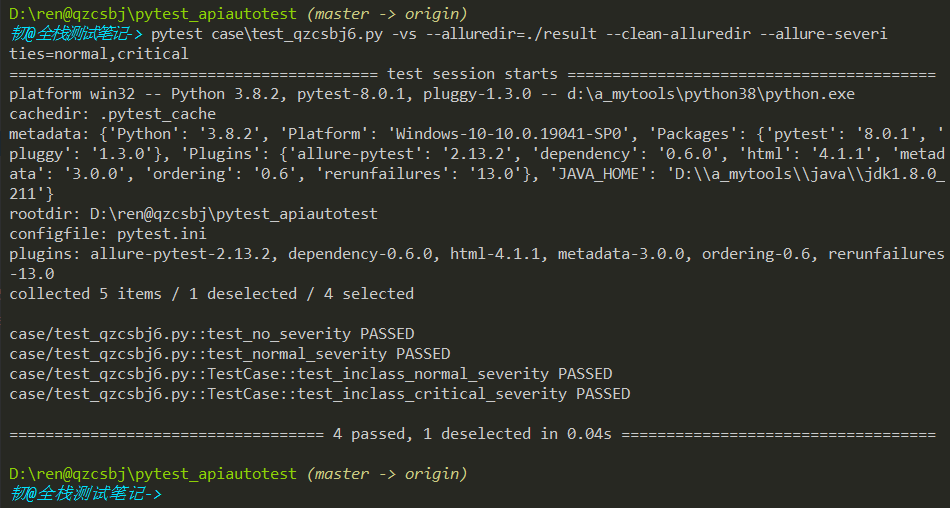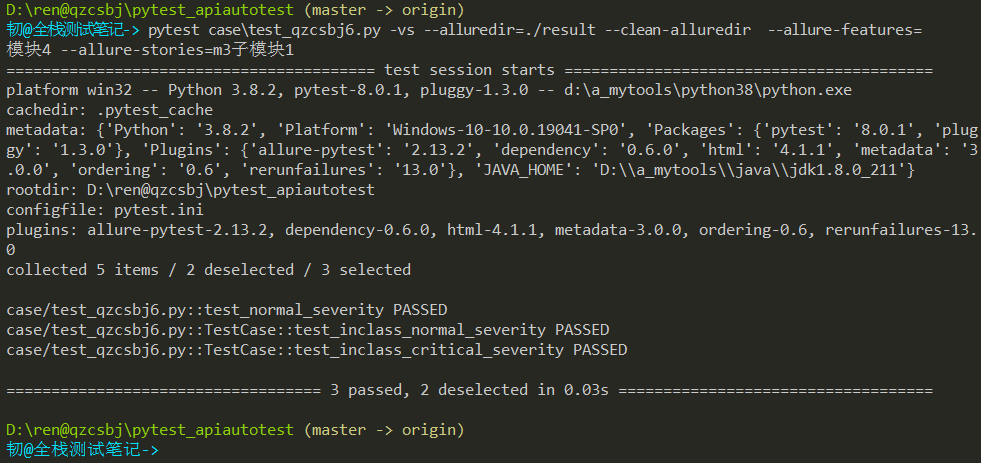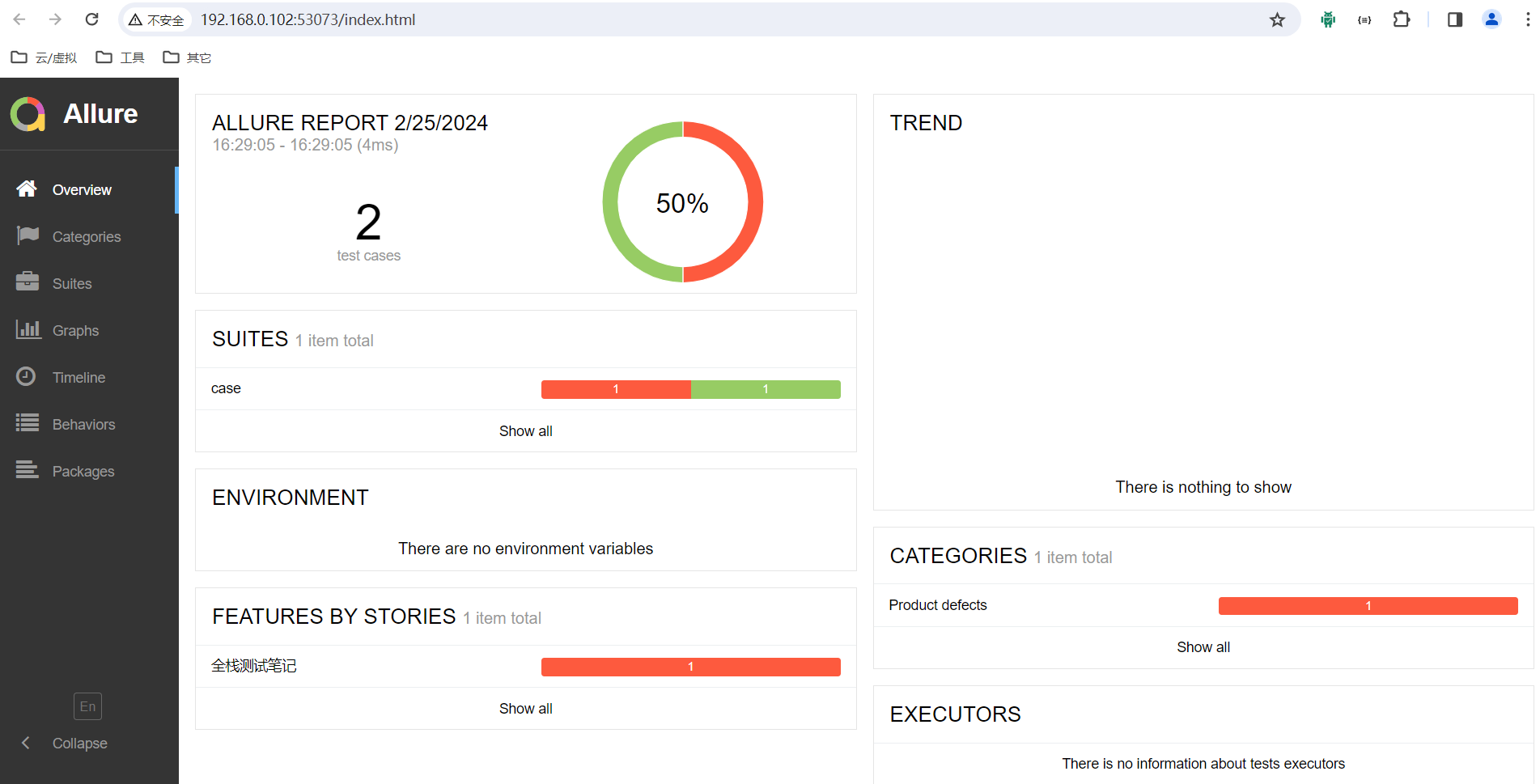pytest简易教程(36):pytest + allure最佳实践
pytest简易教程汇总,详见:https://www.cnblogs.com/uncleyong/p/17982846
简介
上一篇我们已经生成了allure报告,但是可读性不是很强,
所以我们还需要对报告优化,也就是通过allure提供的装饰器添或者代码方式加一些描述信息。
官方示例:https://github.com/allure-examples/allure-examples
常用装饰器

说明:
- feature和story类似于父子关系
- 如果不加 @allure.feature、@allure.story,在Behaviors下测试用例就不会分类显示
- 如果没有添加 @allure.title() ,测试用例的标题默认就是函数名
添加方式及常用格式
方式一:装饰器
放在测试用例上,也就是测试方法上
1 2 3 4 5 6 | @allure.epic("项目")@allure.feature("模块")@allure.story("子模块")@allure.title("标题")@allure.severity(allure.severity_level.CRITICAL)@allure.description("描述") |
优点:可以指定feature、story、severity运行,--allure-features="xxx" --alure-stories="xxx","yyy" --allure-severities blocker,critical,normal

不足:每个用例分别添加描述信息比较繁琐
补充:severity_level的值是枚举

方式二:代码(推荐)
放在测试用例下,也就是测试方法下
1 2 3 4 5 6 | allure.dynamic.epic("项目")allure.dynamic.feature("模块")allure.dynamic.story("子模块")allure.dynamic.title("标题")allure.dynamic.severity("优先级")allure.dynamic.description("描述") |
优点:描述信息实现参数化
不足:不能指定feature、story、severity运行
实际工作中,如果用到参数化,描述信息可以放到参数化数据中,这样就可以用方式二读取测试数据动态生成描述信息。
报告添加severity(装饰器方式)
应用场景:想要根据优先级执行用例,可以通过allure.severity来添加标记
示例代码:
1 2 3 4 5 6 7 8 9 10 11 12 13 14 15 16 17 18 19 20 21 22 23 24 25 26 27 28 29 30 31 32 33 34 35 36 37 38 | #!/usr/bin/env python# -*- coding: utf-8 -*-# @Author : 韧# @wx :ren168632201# @Blog :https://www.cnblogs.com/uncleyong/import allure# 没有指定,默认是normal@allure.feature("模块1")@allure.story("m1子模块1")def test_no_severity(): pass@allure.feature("模块2")@allure.story("m2子模块1")@allure.severity(allure.severity_level.TRIVIAL)def test_trivial_severity(): pass@allure.feature("模块3")@allure.story("m3子模块1")@allure.severity(allure.severity_level.NORMAL)def test_normal_severity(): pass@allure.feature("模块4")@allure.story("m4子模块1")@allure.severity(allure.severity_level.NORMAL)class TestCase: def test_inclass_normal_severity(self): pass # 优先级就近原则 @allure.severity(allure.severity_level.CRITICAL) def test_inclass_critical_severity(self): pass |
指定单个优先级执行

指定多个优先级执行

指定单个模块执行

指定模块和优先级执行,结果是并集,不是交集

同时指定模块和子模块执行,结果是并集,不是交集
pytest case\test_qzcsbj6.py -vs --alluredir=./result --clean-alluredir --allure-features=模块4 --allure-stories=m3子模块1

报告添加epic、feature、story、title、severity、description(代码方式)
应用场景:在Behaviors下测试用例分类显示,在用例详情中显示severity和description
比如接口自动化中
1 2 3 4 5 6 7 8 9 10 11 12 13 14 15 16 17 18 19 20 21 22 23 24 25 26 27 28 29 30 31 32 33 34 35 36 37 38 39 40 41 42 43 44 45 46 47 48 49 50 51 52 53 54 55 56 57 58 59 60 61 62 63 | #!/usr/bin/env python# -*- coding: utf-8 -*-# @Author : 韧# @wx :ren168632201# @Blog :https://www.cnblogs.com/uncleyong/import allureimport pytestdata = [ { "epic":"全栈测试笔记", "feature":"用户模块", "story":"用户注册", "title":"用户注册成功", "description":"desc - 用户注册成功", "severity":"critical", "request":{ "url":"/qzcsbj/user/register", "method":"post", "headers": {'Content-Type': 'application/json'}, "params":{"uname":"qzcsbj","pwd":"123456"} } }, { "epic": "全栈测试笔记", "feature": "用户模块", "story": "用户注册", "title": "用户注册失败", "description": "desc - 用户注册失败", "severity":"critical", "request": { "url": "/qzcsbj/user/register", "method": "post", "headers": {'Content-Type': 'application/json'}, "params": {"uname": "ren", "pwd": "666666"} } }, { "epic": "全栈测试笔记", "feature": "订单模块", "story": "查询订单", "title": "查询订单成功", "description": "desc - 查询订单成功", "severity":"normal", "request": { "url": "/qzcsbj/order/search", "method": "post", "headers": {'Content-Type': 'application/json'}, "params": {"product": "thinkpad"} } }]@pytest.mark.parametrize('casedata',data)class TestCase: def test_case(self, casedata): allure.dynamic.epic(casedata["epic"]) allure.dynamic.feature(casedata["feature"]) allure.dynamic.story(casedata["story"]) allure.dynamic.title(casedata["title"]) allure.dynamic.severity(casedata["severity"]) allure.dynamic.description(casedata["description"]) print(f"---测试数据是:{casedata['request']}") assert 1==1 |
运行结果:

生成测试报告

打开报告



其它参考:有动态allure描述和无动态allure描述(https://www.cnblogs.com/uncleyong/p/18050265)
报告添加step
应用场景:ui自动化测试中,测试过程中的每个步骤可以通过step来描述,通过with allure.step():放在测试用例方法里面,测试步骤的代码需要被该语句包含
如果中间某个步骤失败,后面步骤不会执行
示例代码:
1 2 3 4 5 6 7 8 9 10 11 12 13 14 15 16 17 18 19 20 21 22 23 24 25 26 27 28 29 30 31 32 33 | #!/usr/bin/env python# -*- coding: utf-8 -*-# @Author : 韧# @wx :ren168632201# @Blog :https://www.cnblogs.com/uncleyong/import allure@allure.epic("全栈测试笔记")@allure.feature("用户模块")@allure.story("注册")class TestRigister: @allure.title("注册成功") @allure.severity("critical") @allure.description("desc - 注册成功") def test_reg_success(self): with allure.step("步骤1:打开注册页面"): print("打开注册页面") with allure.step("步骤2:输入注册信息"): print("输入注册信息") with allure.step("步骤3:提交注册,注册成功"): print("提交注册,注册成功") assert 1==1 @allure.title("注册失败") @allure.severity("critical") @allure.description("desc - 注册失败") def test_reg_fail(self): with allure.step("步骤1:打开注册页面"): print("打开注册页面") with allure.step("步骤2:输入注册信息"): print("输入注册信息") with allure.step("步骤3:提交注册,注册失败"): print("提交注册,注册失败") assert 1==2 |
执行:

生成最终报告:

打开报告:






右侧多了Test body



报告添加link、issue、testcase
应用场景:
源码:本质上,调用的都是link
1 2 3 4 5 6 7 8 9 10 | def link(url, link_type=LinkType.LINK, name=None): return safely(plugin_manager.hook.decorate_as_link(url=url, link_type=link_type, name=name))def issue(url, name=None): return link(url, link_type=LinkType.ISSUE, name=name)def testcase(url, name=None): return link(url, link_type=LinkType.TEST_CASE, name=name) |
指定link的参数

Link_Type对应源码LinkType,是枚举

1 2 3 4 5 6 7 8 9 10 11 12 13 14 15 16 17 18 19 20 21 22 23 | #!/usr/bin/env python# -*- coding: utf-8 -*-# @Author : 韧# @wx :ren168632201# @Blog :https://www.cnblogs.com/uncleyong/import allureTEST_CASE_LINK = 'https://www.cnblogs.com/uncleyong/'@allure.link("https://www.cnblogs.com/uncleyong/")def test_link(): pass@allure.link("https://www.cnblogs.com/uncleyong/", name="全栈测试笔记")def test_named_link(): pass@allure.issue("16", "bug地址")def test_testcase_link(): pass@allure.testcase(TEST_CASE_LINK, "测试用例管理平台地址")def test_issue_link(): pass |
运行:这里LinkType的值是issue,表示bug地址
pytest case\test_qzcsbj6.py -s -q --alluredir=./result --clean-alluredir --allure-link
-pattern=issue:https://www.cnblogs.com/uncleyong/{}








跳转的地址





优先级默认是normal


报告添加attach
源码:

allure.attach(),用于传文本
- body:文本内容
- name:展示名称
- attachment_type:类型
- extension:扩展名
allure.attach.file(),用于传附件
- source:附件源路径
- name:展示名称
- attachment_type:类型
- extension:扩展名
支持的类型
1 2 3 4 5 6 7 8 9 10 11 12 13 14 15 16 17 18 19 20 21 22 23 24 25 26 27 28 29 | class AttachmentType(Enum): def __init__(self, mime_type, extension): self.mime_type = mime_type self.extension = extension TEXT = ("text/plain", "txt") CSV = ("text/csv", "csv") TSV = ("text/tab-separated-values", "tsv") URI_LIST = ("text/uri-list", "uri") HTML = ("text/html", "html") XML = ("application/xml", "xml") JSON = ("application/json", "json") YAML = ("application/yaml", "yaml") PCAP = ("application/vnd.tcpdump.pcap", "pcap") PNG = ("image/png", "png") JPG = ("image/jpg", "jpg") SVG = ("image/svg-xml", "svg") GIF = ("image/gif", "gif") BMP = ("image/bmp", "bmp") TIFF = ("image/tiff", "tiff") MP4 = ("video/mp4", "mp4") OGG = ("video/ogg", "ogg") WEBM = ("video/webm", "webm") PDF = ("application/pdf", "pdf") |
示例代码:
1 2 3 4 5 6 7 8 9 10 11 12 13 14 15 16 17 18 19 20 21 22 23 24 25 26 27 28 29 30 31 32 33 34 35 36 37 38 39 40 41 42 43 44 45 | #!/usr/bin/env python# -*- coding: utf-8 -*-# @Author : 韧# @wx :ren168632201# @Blog :https://www.cnblogs.com/uncleyong/import allure@allure.epic("全栈测试笔记")@allure.feature("用户模块")@allure.story("注册")class TestRigister: # @allure.title("注册成功") # @allure.severity("critical") # @allure.description("desc - 注册成功") # def test_reg_success(self): # with allure.step("步骤1:打开注册页面"): # print("打开注册页面") # with allure.step("步骤2:输入注册信息"): # print("输入注册信息") # with allure.step("步骤3:提交注册,注册成功"): # print("提交注册,注册成功") # assert 1 == 1 @allure.title("注册失败") @allure.severity("critical") @allure.description("desc - 注册失败") def test_reg_fail(self): with allure.step("步骤1:打开注册页面"): print("打开注册页面") allure.attach("文本信息", name="文本", attachment_type=allure.attachment_type.TEXT) with allure.step("步骤2:输入注册信息"): print("输入注册信息") allure.attach('<div class="wx"><img src="https://files-cdn.cnblogs.com/files/uncleyong/wx.bmp" alt="微信:ren168632201"></div>', name="html", attachment_type=allure.attachment_type.HTML) with allure.step("步骤3:提交注册,注册失败"): print("提交注册,注册失败") allure.attach.file("D:\wx.png", name="这是图片", attachment_type=allure.attachment_type.JPG, extension="jpg") assert 1 == 1 |
图片在D盘

运行

生成并打开报告

结果:右侧步骤可以看到添加的文本、html、图片

思考题
动态添加描述信息,比如feature、story等,
1 2 | allure.dynamic.feature("模块")allure.dynamic.story("子模块") |
如果实现指定feature、story运行测试用例?
比如:
pytest -s -q --alluredir=./result --clean-alluredir --allure-features=用户模块 --allure-stories=登录
pytest -s -q --alluredir=./result --clean-alluredir --allure-stories=登录
pytest -s -q --alluredir=./result --clean-alluredir --allure-severities=normal,critical
> > > > > > 下一系列:自动化测试框架开发(python + pytest + requests + allure + jsonpath + pyyaml)
__EOF__

关于博主:擅长性能、全链路、自动化、企业级自动化持续集成(DevTestOps)、测开等
面试必备:项目实战(性能、自动化)、简历笔试,https://www.cnblogs.com/uncleyong/p/15777706.html
测试提升:从测试小白到高级测试修炼之路,https://www.cnblogs.com/uncleyong/p/10530261.html
欢迎分享:如果您觉得文章对您有帮助,欢迎转载、分享,也可以点击文章右下角【推荐】一下!



【推荐】国内首个AI IDE,深度理解中文开发场景,立即下载体验Trae
【推荐】编程新体验,更懂你的AI,立即体验豆包MarsCode编程助手
【推荐】抖音旗下AI助手豆包,你的智能百科全书,全免费不限次数
【推荐】轻量又高性能的 SSH 工具 IShell:AI 加持,快人一步
· 无需6万激活码!GitHub神秘组织3小时极速复刻Manus,手把手教你使用OpenManus搭建本
· C#/.NET/.NET Core优秀项目和框架2025年2月简报
· Manus爆火,是硬核还是营销?
· 终于写完轮子一部分:tcp代理 了,记录一下
· 【杭电多校比赛记录】2025“钉耙编程”中国大学生算法设计春季联赛(1)